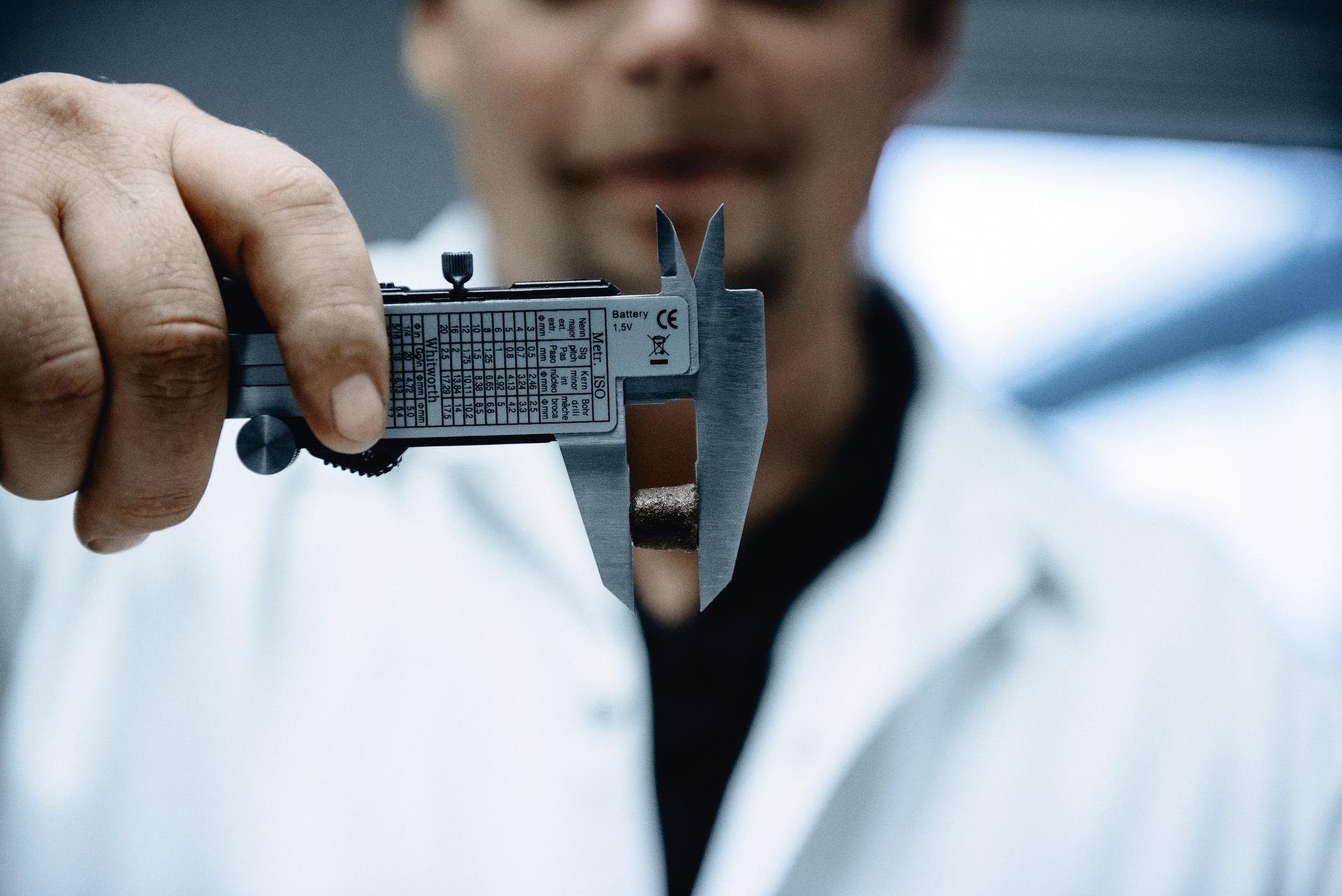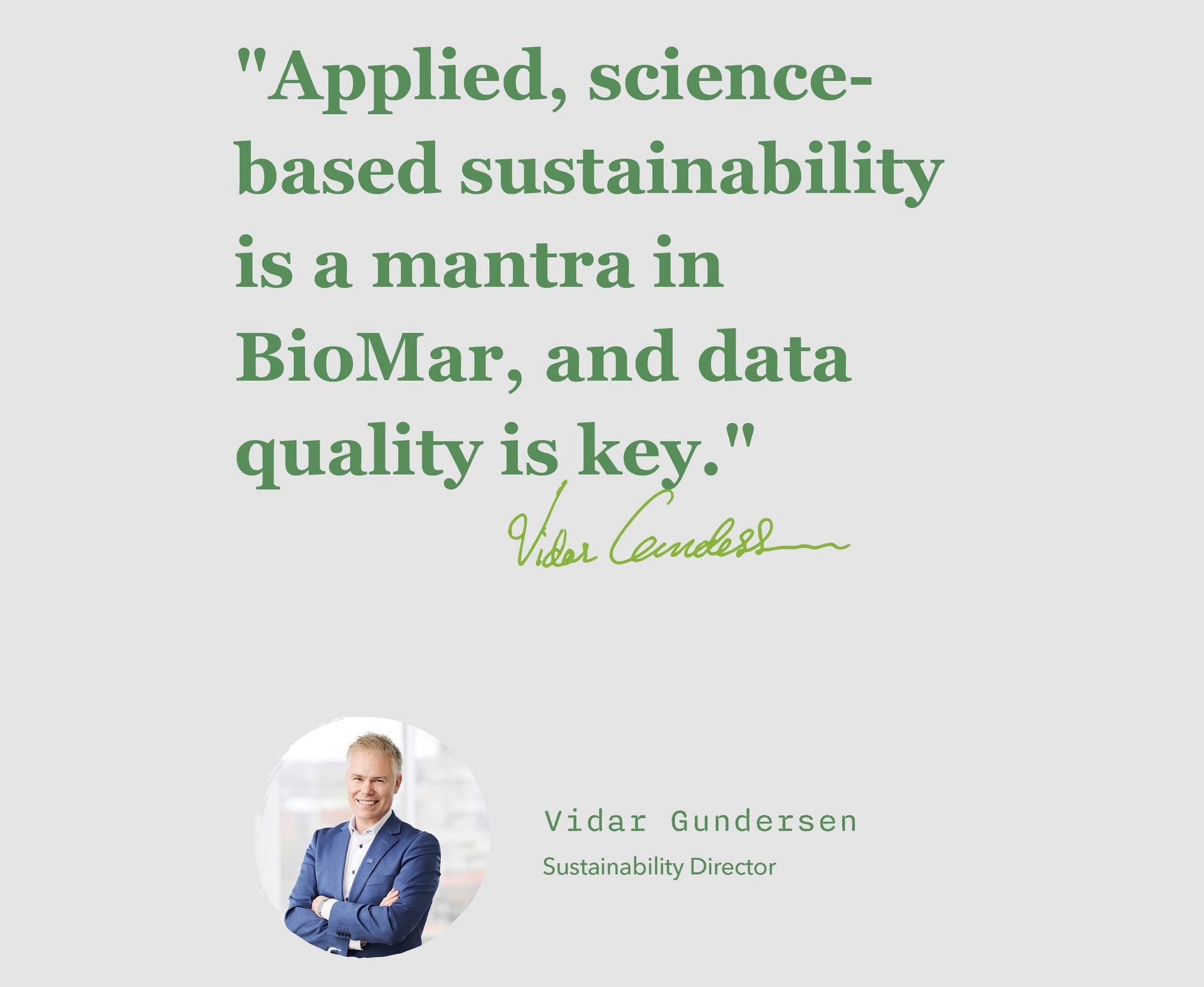- Klimaindsats
Klimaindsats
BioMar er en frontløber hvad angår emissionsreduktion inden for vores branche.
Fish meal is widely regarded as one of the most efficient and complete protein sources available for aquafeeds. It provides farmed fish with a rich supply of essential amino acids, high-quality proteins, vitamins and minerals, all of which are critical for rapid growth, metabolic health, and immune system function. For many species, particularly in early life stages, fish meal remains an irreplaceable component of nutritionally balanced feed due to its digestibility and nutrient density.
Low carbon footprint and full traceability
An important environmental advantage of fish meal is its low carbon footprint. Compared to other protein sources, fish meal ranks among the lowest in carbon emissions per unit of protein delivered, making it a valuable component of a climate-conscious diet.

The environmental impact of fishmeal, however, depends heavily on how it is sourced and processed. Fishmeal belongs to the marine proteins category and is primarily derived from small pelagic fish species like anchovies, blue whiting, capelin, sprat and herring that are not widely consumed by humans.
To ensure sustainable sourcing, full traceability is essential. Responsible producers now provide comprehensive documentation covering:
Species used
Catching area
Transport and storage conditions
Processing methods
This level of transparency allows us to trace raw materials throughout the entire supply chain – from catch to finished product, ensuring that each batch meets our strict requirements.
Our fish meal comes exclusively from approved suppliers, and we maintain full traceability to ensure that standards for sustainability, quality, and food safety are consistently met. In addition, third-party certifications such as MarinTrust and the Marine Stewardship Council (MSC) further verify that fish meal and other marine ingredients originate from legal, responsibly managed, and sustainable fisheries.
Circular by design
Aquafeed is increasingly aligned with circular economy principles, transforming low-value fish, by-products, and other non-human-edible resources into high-quality protein for aquaculture.
While some of these species are technically edible, they are often underutilized in global diets or lack consistent demand in food markets. More importantly, many of these fish are naturally consumed by wild fish so using them in aquafeed mirrors natural food chains in a managed, traceable way.
In addition, a growing share of fish meal and fish oil now comes from the fish processing by-products of fish such as heads, bones and tails which would otherwise go to waste. Fish that are rejected and therefore, unusable due to quality are also included. This upcycling of marine resources strengthens aquaculture’s role in a circular and efficient food system.
One of the key sustainability metrics in aquaculture is the Forage Fish Dependency Ratio (FFDR), which measures how many kilograms of wild fish are used to produce 1 kg of farmed fish. Due to feed innovation and efficiency gains, modern aquaculture species like salmon and trout can now achieve FFDRs well below 1. In contrast, wild fish require significantly more fish to grow, often consuming 5 to 10 times more than farmed fish to gain the same weight.
Ultimately, a lower FFDR reflects an aquaculture system that is less dependent on wild fish inputs, more circular in design, and aligned with responsible resource management.
Fish-based ingredients are part of aquaculture feed — but used thoughtfully, with an emphasis on efficiency and alignment with natural marine ecosystems. The industry is increasingly central to building a more sustainable, traceable, and resilient global food system.
Resultater (39)

BioMar er en frontløber hvad angår emissionsreduktion inden for vores branche.

Fisk og skaldyr er meget tilpasningsdygtige og har brug for omkring 40 essentielle næringsstoffer, som kan komme fra forskellige råmaterialer, herunder marine ingredienser, animalske produkter, korn og nye kilder. Denne tilpasningsevne er afgørende for branchens vækst og vil give mulighed for forskellige foderformuleringer.

Specialized BioMar feeds designed for performance, resilience, and efficiency in cold-water conditions Winter brings real challenges for trout farmers. As temperatures drop, metabolism slows, appetite declines, and maintaining growth can feel like an uphill battle. BioMar’s winter feeds are developed to keep your fish progressing through the toughest months delivering reliable intake, efficient conversion, and strong resilience all winter long.

Slagteklare laks blev analyseret for at bestemme den spiselige del. Resultatet viste, at hele 74 procent af laksen bestod af rent fiskekød.

Wheat gluten is a common ingredient in modern aquaculture diets, valued for a combination of nutritional and functional advantages. It isn’t a magic ingredient, but it consistently supports efficient feed production and healthy fish growth. One of its best-known traits is its strong binding ability earning it the occasional nickname “super glue.” This natural binding property allows many feed mills to reduce or even eliminate synthetic binders.

FLAG-emissioner (Forest, Land and Agriculture) vil være vigtige, når akvakulturindustrien skifter til produktion med lavere kulstofindhold. Disse udledninger, som nu spores under Science-Based Targets-initiativet (SBTi), stammer fra arealanvendelse og landbrugsaktiviteter snarere end fra energiforbrug.
?w=1920&%24withDefaultImage%24=&fmt=auto)
Hos BioMar forstår vi, at rejsen til enestående fisk og rejer begynder længe før, den når bordet, og den starter med det foder, der giver næring til fisk og rejer.

At the BioMar factory in Denmark, we assist salmon and trout farmers with tailored solutions, backed by our technical expert team, BioFarm. These advisors are dedicated to sharing knowledge on pigmentation strategies, helping our partners achieve top-quality fish fillets.

As the fourth most-produced oilseed meal globally, sunflower seed meal offers a strong balance of nutritional quality, affordability, and sustainability that supports the evolving needs of fish and shrimp producers.

BioMar er den første globale fiskefoderleverandør, som tiltræder 1,5 °C-målet mod nettonuludledning i henhold til Science Based Targets initiative (SBTi).

En rekordlav FFDR på 0,37 blev rapporteret i dag i BioMar's bæredygtighedsrapport for 2024. Denne milepæl blev nået gennem innovativ brug af alternative ingredienser og afskæringer, som nu udgør 55 % af de samlede marine ingredienser. De stadigt skiftende markedsforhold for råvarer kan dog gøre det udfordrende at opretholde denne position over tid.

As the global demand for sustainable aquaculture practices continues to rise, so does the need for alternatives to traditional fish meal and fish oil. One of the most promising innovations in this space is AlgaPrime, a revolutionary ingredient that provides a sustainable and nutritious source of omega-3 fatty acids, particularly DHA.